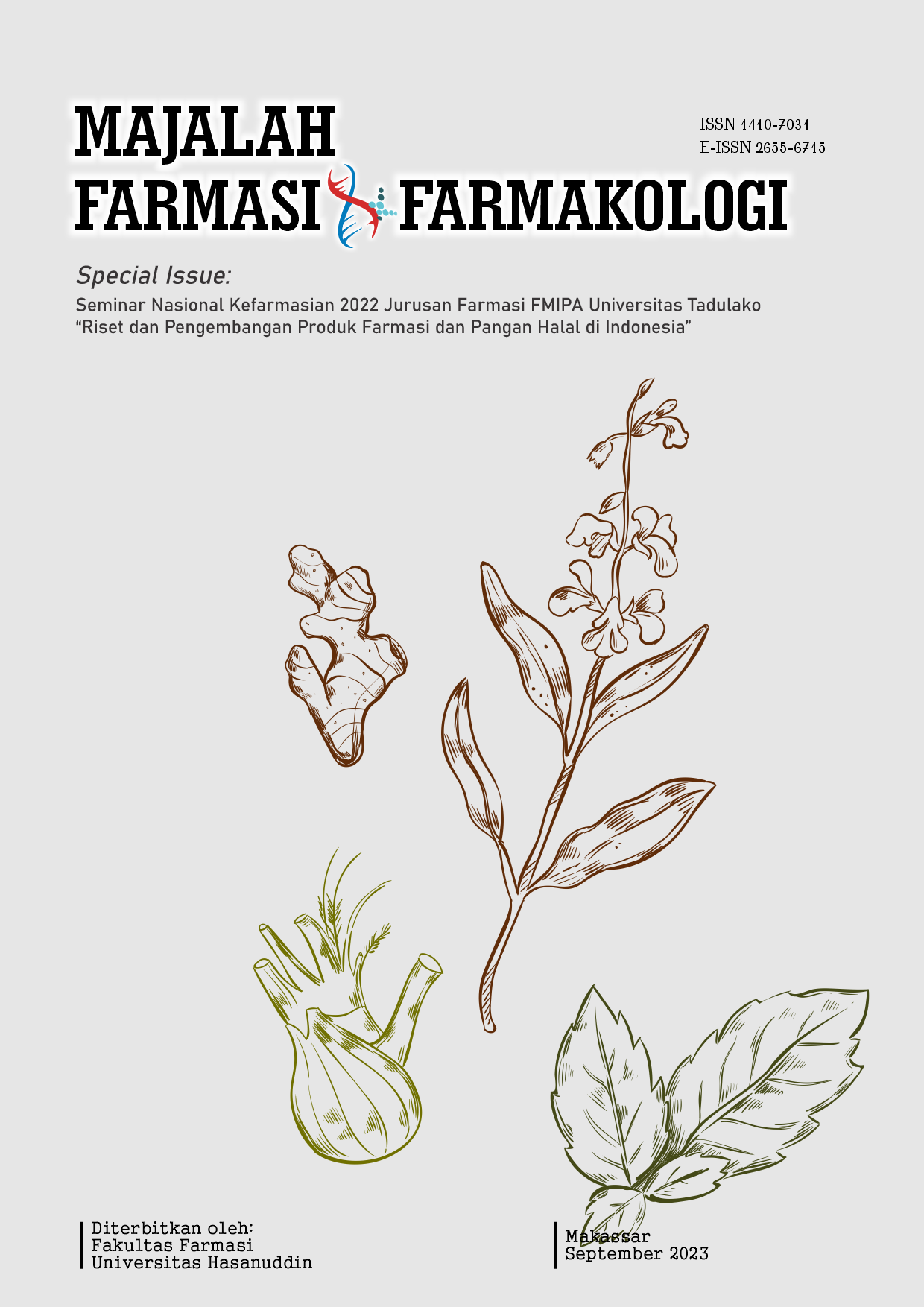STUDI IN SILICO SENYAWA MINYAK ATSIRI KETUMBAR TERHADAP PROTEIN RNA-DEPENDENT RNA POLYMERASE (RdRp) COVID-19
Keywords:
COVID-19, RDRP, Ketumbar, in silico.Abstract
COVID-19 adalah penyakit akibat infeksi virus severe acute respiratory syndrome coronavirus 2 (SARS-CoV-2).
COVID-19 dapat menyebabkan gangguan sistem pernapasan, mulai dari gejala yang ringan seperti flu, hingga
infeksi paru-paru, seperti pneumonia. Sampai sekarang belum ditemukan pengobatan yang sesuai untuk
penyakit COVID-19. Daun ketumbar (Coriander sativum L.) mengandung beberapa minyak atsiri yang
diprediksi dapat berfungsi sebagai antivirus. Tujuan penelitian ini adalah untuk mengetahui gambaran
interaksi secara in silico senyawa minyak atsiri dari daun ketumbar terhadap target protein RNA-dependent
RNA polymerase (RdRp) pada virus COVID-19. Penelitian ini dilakukan dengan menggunakan software
(perangkat lunak) Pyrx dan divisualisasikan dengan software Discovery Studio. Pengunduhan protein RdRP
melalui Protein Data Bank (PDB) dengan kode 6M71. Struktur dua dan tiga dimensi senaywa minyak atsiri dan
kontrol diunduh dengan menggunakan database PubChem. Hasil penelitian menunjukkan senyawa minyak
atsiri daun ketumbar (Coriandrin) memiliki potensi interaksi terbaik antara ligan terhadap RdRp secara in silico
dengan nilai energi -6.5 Kcal/mol. Pada penelitian ini dapat disimpulkan bahwa senyawa minyak atisiri daun
ketumbar mampu terhambat pada protein RdRp secara in silico sehingga berpotensi sebagain anti-COVID-19.
References
World Health Organization (WHO). WHO Coronavirus (COVID-19)
Dashboard [internet]. Geneva: WHO; 2022. Available from:
Florindo HF, Kleiner R, Vaskovich-Koubi D, Acúrcio RC, Carreira B, Yeini
E, Tiram G, Liubomirski Y, Satchi-Fainaro R. Immune-Mediated
Approaches Against COVID-19. Nat Nanotechnol. 2020;15(8):630-645.
DOI: 10.1038/s41565-020-0732-3.
Rathnayake AD, Zheng J, Kim Y, Perera KD, Mackin S, Meyerholz DK,
Kashipathy MM, Battaile KP, Lovell S, Perlman S, Groutas WC, Chang KO.
C-Like Protease Inhibitors Block Coronavirus Replication In Vitro and
Improve Survival in MERS-CoV-Infected Mice. Sci Transl Med. 2020
Aug;12(557):eabc5332. DOI: 10.1126/scitranslmed.abc5332.
Hassanipour S, Arab-Zozani M, Amani B, Heidarzad F, Fathalipour M,
Martinez-de-Hoyo R. The Efficacy and Safety of Favipiravir in Treatment
of COVID-19: A Systematic Review and Meta-Analysis of Clinical Trials.
Sci Rep. 2021;11(1):11022. DOI: 10.1038/s41598-021-90551-6.
Shannon A, Selisko B, Le N, Huchting J, Touret F, Piorkowski G, Fattorini
V, Ferron F, Decroly E, Meier C, Coutard B, Peersen O, Canard B.
Favipiravir Strikes the SARS-CoV-2 at Its Achilles Heel, The RNA
Polymerase. bioRxiv. 2020;15:2020.05.15.098731. DOI:
1101/2020.05.15.098731.
Mandal S, Mandal M. Coriander (Coriandrum sativum L.) Essential Oil:
Chemistry and Biological Activity. Asian Pacific Journal of Tropical
Biomedicine. 2015;5(6):421-428. DOI:10.1016/j.apjtb.2015.04.001.
Kačániová M, Galovičová L, Ivanišová E, Vukovic NL, Štefániková J,
Valková V, Borotová P, Žiarovská J, Terentjeva M, Felšöciová S, Tvrdá E.
Antioxidant, Antimicrobial and Antibiofilm Activity of Coriander
(Coriandrum sativum L.) Essential Oil for Its Application in Foods. Foods.
;9(3):282. DOI: 10.3390/foods9030282.
Sinaga SM, Haro G, Sudarmi S, Iksen I. Phytochemical Screening and
Antihyperglycemic Activity of Ethanolic Extract of Coriandrum sativum
L. Leaf. Rasayan J Chem. 2019;12(4):1992-1996. DOI:
31788/RJC.2019.1245451.
Gurning K, Iksen I, Simanjuntak HA, Purba H. Identification of the
Chemical Compound of Essential Oil from Ketumbar (Coriandrum
sativum L.) Leaves with Gc-Ms. Pharmacogn J. 2020;12(5): 1019-1023.
DOI: 10.5530/pj.2020.12.144.
Islamie R, Iksen I, Buana BC, Gurning K, Syahputra HD, Winata HS.
Construction of Network Pharmacology-Based Approach and Potential
Mechanism From Major Components of Coriander sativum L. against
COVID-19. Pharmacia. 2022;69(3):689-697. DOI:
3897/pharmacia.69.e84388.
García-Godoy MJ, López-Camacho E, García-Nieto J, Aldana-Montes AJ.
Solving Molecular Docking Problems with Multi-Objective
Metaheuristics. Molecules. 2015;20(6):10154-83. DOI:
3390/molecules200610154.
Dallakyan S, Olson AJ. Small-Molecule Library Screening by Docking with
PyRx. Methods Mol Biol. 2015;1263:243-50. DOI: 10.1007/978-1-4939-
-7_19.
Wang G, Zhu W. Molecular Docking for Drug Discovery and
Development: A Widely Used Approach But Far From Perfect. Future
Med Chem. 2016;8(14):1707-1710. DOI: 10.4155/fmc-2016-0143.
Batiha GE, Moubarak M, Shaheen HM, Zakariya AM, Usman IM, Rauf A,
Adhikari A, Dey A, Alexiou A, Hetta HF, Al-Gareeb AI, Al-Kuraishy HM.
Favipiravir in SARS-CoV-2 infection: Is it Worthwhile? Comb Chem High
Throughput Screen. 2022. DOI:
2174/1386207325666220414111840.
Downloads
Published
Issue
Section
License
Copyright (c) 2023 Majalah Farmasi dan Farmakologi

This work is licensed under a Creative Commons Attribution-NonCommercial 4.0 International License.
The copyright to this article is transferred to Universitas Hasanuddin (UNHAS) if and when the article is accepted for publication. The undersigned hereby transfers all rights in and to the paper including without limitation all copyrights to UNHAS. The undersigned hereby represents and warrants that the paper is original and that he/she is the author of the paper, except for material that is clearly identified as to its original source, with permission notices from the copyright owners where required. The undersigned represents that he/she has the power and authority to make and execute this assignment.
We declare that:
- This paper has not been published in the same form elsewhere.
- It will not be submitted anywhere else for publication prior to acceptance/rejection by this Journal.
- A copyright permission is obtained for materials published elsewhere and which require this permission for reproduction.
Furthermore, I/We hereby transfer the unlimited rights of publication of the above-mentioned paper in whole to UNHAS The copyright transfer covers the exclusive right to reproduce and distribute the article, including reprints, translations, photographic reproductions, microform, electronic form (offline, online) or any other reproductions of similar nature.
The corresponding author signs for and accepts responsibility for releasing this material on behalf of any and all co-authors. This agreement is to be signed by at least one of the authors who have obtained the assent of the co-author(s) where applicable. After submission of this agreement signed by the corresponding author, changes of authorship or in the order of the authors listed will not be accepted.


